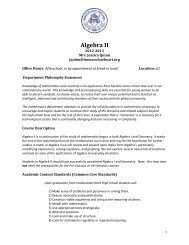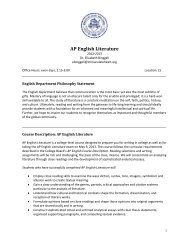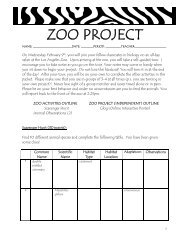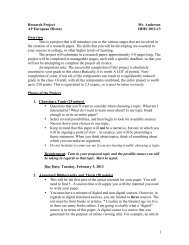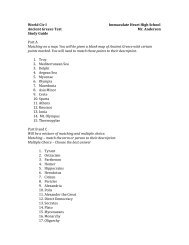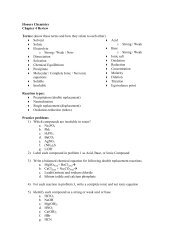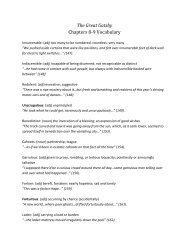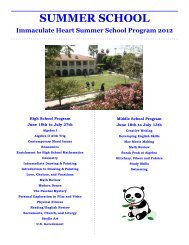Chapter 25 Slides Sections 1-3
Chapter 25 Slides Sections 1-3
Chapter 25 Slides Sections 1-3
You also want an ePaper? Increase the reach of your titles
YUMPU automatically turns print PDFs into web optimized ePapers that Google loves.
“…sparked by just the right<br />
combination of physical events<br />
& chemical processes…”<br />
Origin of Life<br />
AP Biology 2010-2011
Millions of years ago<br />
ARCHEAN<br />
PROTEROZOIC<br />
PRECAMBRIAN<br />
0<br />
500<br />
1000<br />
Cenozoic<br />
Mesozoic<br />
Paleozoic<br />
Colonization of land<br />
by animals<br />
Appearance of animals<br />
and land plants<br />
First multicellular<br />
organisms<br />
Bacteria Archaebacteria<br />
Protista Plantae<br />
Fungi<br />
Animalia<br />
1500<br />
Oldest definite fossils<br />
of eukaryotes<br />
2000<br />
<strong>25</strong>00<br />
3000<br />
3500<br />
4000<br />
4500<br />
AP Biology<br />
Appearance of oxygen<br />
in atmosphere<br />
Oldest definite fossils<br />
of prokaryotes<br />
Molten-hot surface of<br />
earth becomes cooler<br />
Formation of earth<br />
The evolutionary tree of<br />
life can be documented<br />
with evidence.<br />
The Origin of Life on<br />
Earth is another story…
Concept <strong>25</strong>.1: Conditions on early<br />
Earth made the origin of life possible<br />
• Chemical and physical processes on early<br />
Earth may have produced very simple cells<br />
through a sequence of stages:<br />
1. Abiotic synthesis of small organic molecules<br />
2. Joining of these small molecules into<br />
macromolecules<br />
3. Packaging of molecules into protocells<br />
4. Origin of self-replicating molecules<br />
AP Biology<br />
© 2011 Pearson Education, Inc.
AP Biology<br />
Synthesis of Organic Compounds on<br />
Early Earth<br />
• Earth formed about 4.6 billion years ago, along<br />
with the rest of the solar system<br />
• Bombardment of Earth by rocks and ice likely<br />
vaporized water and prevented seas from<br />
forming before 4.2 to 3.9 billion years ago<br />
• Earth’s early atmosphere likely contained<br />
water vapor and chemicals released by<br />
volcanic eruptions (nitrogen, nitrogen oxides,<br />
carbon dioxide, methane, ammonia, hydrogen,<br />
hydrogen sulfide)<br />
© 2011 Pearson Education, Inc.
• In the 1920s, A. I. Oparin and J. B. S. Haldane<br />
hypothesized that the early atmosphere was a<br />
reducing environment<br />
• In 1953, Stanley Miller and Harold Urey<br />
conducted lab experiments that showed that<br />
the abiotic synthesis of organic molecules in a<br />
reducing atmosphere is possible<br />
AP Biology<br />
© 2011 Pearson Education, Inc.
• However, the evidence is not yet convincing<br />
that the early atmosphere was in fact reducing<br />
• Instead of forming in the atmosphere, the first<br />
organic compounds may have been<br />
synthesized near volcanoes or deep-sea vents<br />
• Miller-Urey type experiments demonstrate that<br />
organic molecules could have formed with<br />
various possible atmospheres<br />
AP Biology<br />
© 2011 Pearson Education, Inc.
Conditions on early Earth<br />
AP Biology<br />
• Reducing atmosphere<br />
water vapor (H 2 O), CO 2 , N 2 , NO x , H 2 , NH 3 ,<br />
CH 4 , H 2 S<br />
lots of available H & its electron<br />
no free oxygen<br />
• Energy source<br />
lightning, UV radiation,<br />
volcanic<br />
What’s missing<br />
from that<br />
atmosphere?<br />
low O 2 =<br />
organic molecules<br />
do not breakdown<br />
as quickly
Origin of Organic Molecules<br />
• Abiotic synthesis<br />
1920<br />
Oparin & Haldane<br />
organic molecules<br />
can form from<br />
inorganic<br />
molecules<br />
1953<br />
Miller & Urey<br />
test hypothesis<br />
• formed organic<br />
compounds<br />
AP Biology<br />
• amino acids<br />
• adenine<br />
Water vapor<br />
Mixture of gases<br />
("primitive<br />
atmosphere")<br />
Heated water<br />
("ocean")<br />
Electrodes discharge<br />
sparks<br />
(lightning simulation)<br />
NH 3<br />
CH 4<br />
H 2<br />
Condenser<br />
Water<br />
Condensed<br />
liquid with<br />
complex,<br />
organic<br />
molecules
Stanley Miller<br />
University of Chicago<br />
produced<br />
-amino acids<br />
-hydrocarbons<br />
-nitrogen bases<br />
-other organics<br />
AP Biology<br />
Why was<br />
this experiment<br />
important??!
Key Events in Origin of Life<br />
• Origin of Cells (Protocells)<br />
lipid bubbles separate inside from outside<br />
metabolism & reproduction<br />
• Origin of Genetics<br />
RNA is likely first genetic material<br />
multiple functions: encodes information (selfreplicating),<br />
enzyme, regulatory molecule,<br />
transport molecule (tRNA, mRNA)<br />
• makes inheritance possible<br />
• makes natural selection & evolution possible<br />
• Origin of Eukaryotes<br />
endosymbiosis<br />
AP Biology
Abiotic Synthesis of Macromolecules<br />
• RNA monomers have been produced<br />
spontaneously from simple molecules<br />
• Small organic molecules polymerize when they<br />
are concentrated on hot sand, clay, or rock<br />
AP Biology<br />
© 2011 Pearson Education, Inc.
Protocells<br />
• Replication and metabolism are key properties<br />
of life and may have appeared together<br />
• Protocells may have been fluid-filled vesicles<br />
with a membrane-like structure<br />
• In water, lipids and other organic molecules<br />
can spontaneously form vesicles with a lipid<br />
bilayer<br />
AP Biology<br />
© 2011 Pearson Education, Inc.
• Adding clay can increase the rate of vesicle<br />
formation<br />
• Vesicles exhibit simple reproduction and<br />
metabolism and maintain an internal chemical<br />
environment<br />
AP Biology<br />
© 2011 Pearson Education, Inc.
Relative turbidity,<br />
an index of vesicle number<br />
Figure <strong>25</strong>.3<br />
0.4<br />
0.2<br />
Precursor<br />
molecules only<br />
Precursor molecules plus<br />
montmorillonite clay<br />
0<br />
0<br />
20 40<br />
60<br />
Time (minutes)<br />
(a) Self-assembly<br />
Vesicle<br />
boundary<br />
1 m<br />
AP Biology<br />
(b) Reproduction<br />
20 m<br />
(c) Absorption of RNA
Self-Replicating RNA and the Dawn of<br />
Natural Selection<br />
• The first genetic material was probably RNA,<br />
not DNA<br />
• RNA molecules called ribozymes have been<br />
found to catalyze many different reactions<br />
For example, ribozymes can make<br />
complementary copies of short stretches of<br />
RNA<br />
AP Biology<br />
© 2011 Pearson Education, Inc.
Concept <strong>25</strong>.2: The fossil record<br />
documents the history of life<br />
• The fossil record reveals changes in the<br />
history of life on Earth<br />
AP Biology<br />
© 2011 Pearson Education, Inc.
The Fossil Record<br />
• Sedimentary rocks are deposited into layers<br />
called strata and are the richest source of<br />
fossils<br />
AP Biology<br />
© 2011 Pearson Education, Inc.
Figure <strong>25</strong>.4<br />
Dimetrodon<br />
Present<br />
100 mya<br />
Rhomaleosaurus<br />
victor<br />
0.5 m<br />
175<br />
200<br />
1 m<br />
Tiktaalik<br />
Coccosteus<br />
cuspidatus<br />
4.5 cm<br />
270<br />
300<br />
375<br />
400<br />
Hallucigenia<br />
1 cm<br />
Stromatolites<br />
500<br />
5<strong>25</strong><br />
565<br />
600<br />
2.5 cm<br />
Dickinsonia<br />
costata<br />
AP Biology<br />
Fossilized<br />
stromatolite<br />
1,500<br />
3,500<br />
Tappania
• Few individuals have fossilized, and even<br />
fewer have been discovered<br />
• The fossil record is biased in favor of species<br />
that<br />
Existed for a long time<br />
Were abundant and widespread<br />
Had hard parts<br />
AP Biology<br />
© 2011 Pearson Education, Inc.
How Rocks and Fossils Are Dated<br />
• Sedimentary strata reveal the relative ages of<br />
fossils<br />
• The absolute ages of fossils can be<br />
determined by radiometric dating<br />
• A “parent” isotope decays to a “daughter”<br />
isotope at a constant rate<br />
• Each isotope has a known half-life, the time<br />
required for half the parent isotope to decay<br />
AP Biology<br />
© 2011 Pearson Education, Inc.
Fraction of parent<br />
isotope remaining<br />
Figure <strong>25</strong>.5<br />
Accumulating<br />
“daughter”<br />
isotope<br />
1 2<br />
1 4<br />
1 8<br />
1 16<br />
Remaining<br />
“parent”<br />
isotope<br />
AP Biology<br />
1 2 3 4<br />
Time (half-lives)
• Radiocarbon dating can be used to date fossils<br />
up to 75,000 years old<br />
• For older fossils, some isotopes can be used<br />
to date sedimentary rock layers above and<br />
below the fossil<br />
AP Biology<br />
© 2011 Pearson Education, Inc.
Concept <strong>25</strong>.3: Key events in life’s<br />
history include the origins of singlecelled<br />
and multicelled organisms and<br />
the colonization of land<br />
• The geologic record is divided into the<br />
Archaean, the Proterozoic, and the<br />
Phanerozoic eons<br />
• The Phanerozoic encompasses multicellular<br />
eukaryotic life<br />
• The Phanerozoic is divided into three eras: the<br />
Paleozoic, Mesozoic, and Cenozoic<br />
AP Biology<br />
© 2011 Pearson Education, Inc.
AP Biology<br />
© 2011 Pearson Education, Inc.<br />
Animation: The Geologic Record<br />
Right-click slide / select “Play”
Table <strong>25</strong>.1<br />
AP Biology
Table <strong>25</strong>.1a<br />
AP Biology
Table <strong>25</strong>.1b<br />
AP Biology
Timeline<br />
AP Biology<br />
• Key events in<br />
evolutionary<br />
history of life on<br />
Earth<br />
3.5–4.0 bya:<br />
life originated<br />
2.7 bya:<br />
free O 2 =<br />
photosynthetic<br />
bacteria<br />
2 bya:<br />
first eukaryotes
Figure <strong>25</strong>.7-3<br />
Cenozoic<br />
Humans<br />
Colonization<br />
of land<br />
Animals<br />
Origin of solar<br />
system and<br />
Earth<br />
Multicellular<br />
eukaryotes<br />
1<br />
Proterozoic<br />
4<br />
Archaean<br />
2<br />
3<br />
AP Biology<br />
Single-celled<br />
eukaryotes<br />
Prokaryotes<br />
Atmospheric oxygen
Figure <strong>25</strong>.UN02<br />
1<br />
4<br />
2 3<br />
Prokaryotes<br />
AP Biology
Figure <strong>25</strong>.UN03<br />
1<br />
4<br />
2 3<br />
AP Biology<br />
Atmospheric<br />
oxygen
Photosynthesis and the Oxygen<br />
Revolution<br />
• Most atmospheric oxygen (O 2 ) is of biological<br />
origin<br />
• O 2 produced by oxygenic photosynthesis<br />
reacted with dissolved iron and precipitated<br />
out to form banded iron formations<br />
AP Biology<br />
© 2011 Pearson Education, Inc.
• By about 2.7 billion years ago, O 2 began<br />
accumulating in the atmosphere and rusting<br />
iron-rich terrestrial rocks<br />
• This “oxygen revolution” from 2.7 to 2.3 billion<br />
years ago caused the extinction of many<br />
prokaryotic groups<br />
• Some groups survived and adapted using<br />
cellular respiration to harvest energy<br />
AP Biology<br />
© 2011 Pearson Education, Inc.
(percent of present-day levels; log scale)<br />
Figure <strong>25</strong>.8<br />
1,000<br />
100<br />
Atmospheric O 2<br />
10<br />
1<br />
0.1<br />
0.01<br />
“Oxygen<br />
revolution”<br />
0.001<br />
0.0001<br />
4 3 2 1 0<br />
Time (billions of years ago)<br />
AP Biology
Figure <strong>25</strong>.UN04<br />
1<br />
4<br />
AP Biology<br />
Singlecelled<br />
eukaryotes<br />
2 3
The First Eukaryotes<br />
• The oldest fossils of eukaryotic cells date back<br />
2.1 billion years<br />
• Eukaryotic cells have a nuclear envelope,<br />
mitochondria, endoplasmic reticulum, and a<br />
cytoskeleton<br />
• The endosymbiont theory proposes that<br />
mitochondria and plastids (chloroplasts and<br />
related organelles) were formerly small<br />
prokaryotes living within larger host cells<br />
• An endosymbiont is a cell that lives within a<br />
host cell<br />
AP Biology<br />
© 2011 Pearson Education, Inc.
First Eukaryotes<br />
• Development of internal membranes<br />
create internal micro-environments<br />
advantage: specialization = increase efficiency<br />
infolding of the<br />
plasma membrane<br />
• natural selection!<br />
plasma<br />
membrane<br />
endoplasmic<br />
reticulum (ER)<br />
~2 bya<br />
nuclear envelope<br />
nucleus<br />
DNA<br />
AP Biology<br />
Prokaryotic<br />
cell<br />
cell wall<br />
Prokaryotic<br />
ancestor of<br />
eukaryotic<br />
cells<br />
plasma<br />
membrane<br />
Eukaryotic<br />
cell
1 st Endosymbiosis<br />
• Evolution of eukaryotes<br />
<br />
<br />
<br />
origin of mitochondria<br />
engulfed aerobic bacteria, but<br />
did not digest them<br />
mutually beneficial relationship<br />
• natural selection!<br />
internal membrane<br />
system<br />
aerobic bacterium<br />
mitochondrion<br />
Endosymbiosis<br />
Ancestral<br />
eukaryotic cell<br />
AP Biology<br />
Eukaryotic cell<br />
with mitochondrion
2 nd Endosymbiosis<br />
• Evolution of eukaryotes<br />
origin of chloroplasts<br />
engulfed photosynthetic bacteria,<br />
but did not digest them<br />
mutually beneficial relationship<br />
• natural selection!<br />
photosynthetic<br />
bacterium<br />
Eukaryotic<br />
cell with<br />
mitochondrion<br />
chloroplast<br />
Endosymbiosis<br />
mitochondrion<br />
AP Biology<br />
Eukaryotic cell with<br />
chloroplast & mitochondrion
Theory of Endosymbiosis<br />
• Evidence<br />
AP Biology<br />
structural<br />
• mitochondria & chloroplasts<br />
resemble bacterial structure<br />
genetic<br />
• mitochondria & chloroplasts<br />
have their own circular DNA, like bacteria<br />
functional<br />
• mitochondria & chloroplasts<br />
move freely within the cell<br />
• mitochondria & chloroplasts<br />
reproduce independently<br />
from the cell<br />
Lynn Margulis
Figure <strong>25</strong>.UN05<br />
1<br />
4<br />
2 3<br />
AP Biology<br />
Multicellular<br />
eukaryotes
The Origin of Multicellularity<br />
• The evolution of eukaryotic cells allowed for a<br />
greater range of unicellular forms<br />
• A second wave of diversification occurred<br />
when multicellularity evolved and gave rise to<br />
algae, plants, fungi, and animals<br />
AP Biology<br />
© 2011 Pearson Education, Inc.
Figure <strong>25</strong>.UN06<br />
Animals<br />
1<br />
4<br />
2 3<br />
AP Biology
Cambrian explosion<br />
• Diversification of Animals<br />
within 10–20 million years most of the major<br />
phyla of animals appear in fossil record<br />
543 mya<br />
AP Biology
AP Biology
The Cambrian Explosion<br />
• The Cambrian explosion refers to the sudden<br />
appearance of fossils resembling modern<br />
animal phyla in the Cambrian period (535 to<br />
5<strong>25</strong> million years ago)<br />
• A few animal phyla appear even earlier:<br />
sponges, cnidarians, and molluscs<br />
• The Cambrian explosion provides the first<br />
evidence of predator-prey interactions<br />
AP Biology<br />
© 2011 Pearson Education, Inc.
Figure <strong>25</strong>.10<br />
Sponges<br />
Cnidarians<br />
Echinoderms<br />
Chordates<br />
Brachiopods<br />
Annelids<br />
Molluscs<br />
Arthropods<br />
AP Biology<br />
PROTEROZOIC<br />
Ediacaran<br />
PALEOZOIC<br />
Cambrian<br />
635 605 575 545 515 485 0<br />
Time (millions of years ago)
Figure <strong>25</strong>.UN07<br />
Colonization of land<br />
1<br />
4<br />
2 3<br />
AP Biology
The Colonization of Land<br />
• Fungi, plants, and animals began to colonize<br />
land about 500 million years ago<br />
• Vascular tissue in plants transports materials<br />
internally and appeared by about 420 million<br />
years ago<br />
• Plants and fungi today form mutually<br />
beneficial associations and likely colonized<br />
land together<br />
AP Biology<br />
© 2011 Pearson Education, Inc.
• Arthropods and tetrapods are the most<br />
widespread and diverse land animals<br />
• Tetrapods evolved from lobe-finned fishes<br />
around 365 million years ago<br />
AP Biology<br />
© 2011 Pearson Education, Inc.
Is there life elsewhere?<br />
Does it look like life on Earth?<br />
They would<br />
Ask Questions!<br />
AP Biology 2008-2009



